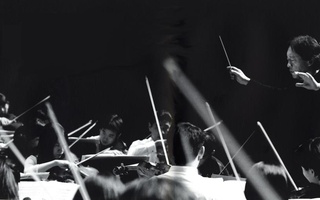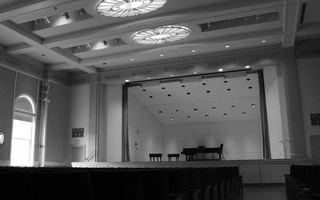The Harvard Crimson: How did ‘Timbre and Flux’ come about?
Larissa D. Koch: I graduated last March and I had enough repertory that I’d made while I was here that I could do an evening of work that I had created as an undergrad. I’ve been really lucky that I’ve continued in the dance scene here through teaching so I presented this idea to the Dance Program that if I could find the people to do a concert, would it be possible for the Program to host my dance company. They said yes.
Since there’s such competition between the dance companies and groups at the Dance Center, I wanted something to complement and not compete with what other student groups were doing. So we’ve organized and rehearsed all summer, and we’ve managed to put together a really wonderful concert.
THC: Why ‘Timbre and Flux’?
LDK: I wanted a title that represented both music and dance elements so I thought about what makes music music and what makes dance dance. Music wouldn’t exist without sound and dance without motion so I thought of the qualities of sound and motion and that’s where I got timbre and flux.
THC: Can you talk about the pieces in the concert and the focus on collaboration?
LDK: All of this repertory except for one piece was preexisting. The new piece is a preview of something that I’ve been invited by the Ballet Company to do for the Loeb Mainstage in collaboration with Hans Tutschku, who is a wonderful electroacoustic composer. The ballet company wanted to pair choreographers with people on the music end. Hans and I have peripherally worked with each other already so it seemed like a natural fit. He’s a very responsive composer, both in terms of what he’s doing musically and also in terms of being aware of how the movement and music interact together.
I’m also restaging a piece that Bong-Inh Koh and I conceived of together involving the cello not just being an accompanist but being a part of the piece, so the cellist is on the stage. The act of playing the cello involves really beautiful movement, and I really wanted to make sure it wasn’t missed.
There is another piece I originally choreographed to recorded music but I’ve always wanted to do it live because I’ve been enamored of the classical guitar for a while. There’s a very human element to having live music that I think gives a dance piece something more when you have the musician present. I’m a really musically- driven choreographer, so I’m trying to do everything I can to make the music in the concert represented as important, because it’s so important to me choreographically.
THC: What do you mean by ‘musically driven’?
LDK: Music inspires movement in me. I’ll fall in love with a piece of music and listen to it again and again and that’s how I get my ideas. It starts with music. I could have an idea for a piece conceptually but before I have the music it doesn’t go anywhere.
THC: Compared to what kind of choreography?
LDK: Merce Cunningham is a classic example of the opposite. Merce would generate movement ideas completely independently of music and sometimes the dancers wouldn’t hear the music until the night of the concert. You would have them happen at the same time and whatever would happen, would happen, so a lot of it was… not accidental, but incidental. It also meant it was different every night. It’s a very different way of thinking about choreography.
The guest choreographers who I asked to work with me have a similar sensibility to me in the way they choreograph. They’re very musical choreographers, and their movement is very thoughtful in its musicality and crafted very carefully in a way that works with the music.
THC: What has been your hardest challenge this summer in organizing this concert?
LDK: The hardest thing for me has been adjusting the way that the process of preparing for a concert feels and is for the dancers, because by nature, it’s different over the summer. Being able to rehearse with some people on a weekly basis and then having some people jump in at the last minute has been very different from what I’m accustomed to. Everyone had to have the resources they needed to feel prepared, so for example, the dancer who was in China all summer had a copy of the piece she was going to do on video. There was a lot more studying involved. It was much less self-contained.
THC: What’s ahead for you?
LDK: I’m going to be a teaching assistant for an introduction to choreography class that is offered by the Committee on Dramatic Arts and taught by Professor Elizabeth Bergmann. I’m choreographing for the show on the Mainstage. I’ve applied to a couple of choreography festivals that are invited. I’m applying to medical school.
THC: How do you balance your choreography and academic goals?
LDK: For a long time I thought it had to be an either/or kind of thing. But there are living examples of how dance can coexist with the medical field. For example, through CPIC (Center for Public Interest Careers), I had the opportunity to mentor with a physician who runs a youth orchestra with her husband.
Figuring out how to navigate how to do both is tricky, but you have to give yourself permission to take one and put it in the backseat. It can be hard. People have exacting standards for themselves and sometimes there’s a feeling that if you can’t do it at peak, you shouldn’t be doing it at all.
Finding a happy medium has been challenging, but it has also been a good exercise. When you let something go for a while you get to rediscover what you really love about it, which is something you don’t get to do if you focus too hard—you become a little myopic. It’s been a blessing in disguise to have to let dance go from time to time. I’ve rediscovered why I’d loved it and I’d forgotten and didn’t even know I’d forgotten until I rediscovered it.
—Denise J. Xu
Read more in Arts
'Ash' is Dust on the PageRecommended Articles
-
SPOTLIGHT: Omara PortuondoOmara Portuondo is a Cuban music and film superstar whose career has spanned over 60 years.
-
 Visualize Music at Silent Rave Friday
Visualize Music at Silent Rave Friday -
 Entertainment and Artistry Converge in South Korean Concert Halls
Entertainment and Artistry Converge in South Korean Concert Halls -
Portrait of an Artist: Jonathan SchakelMusician Jonathan Schakel discusses the organ as an instrument of the mind.
-
Portrait of an Artist: John B. Austin '56Renowned opera composer John B. Austin speaks about his love of composition and music
-
 Paine’s Performance Potential Restored
Paine’s Performance Potential Restored













